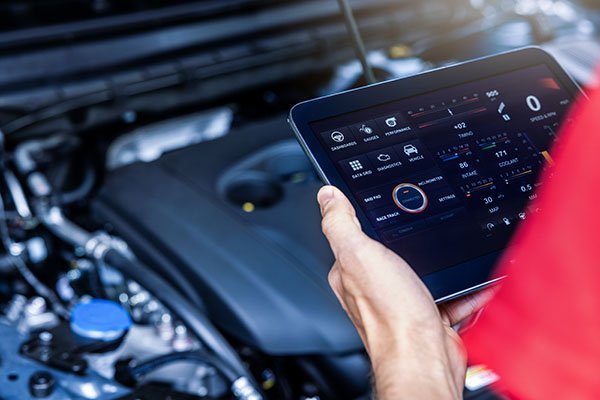
Modern vehicles are equipped with advanced computer systems that monitor and control various components to ensure optimal performance, fuel efficiency, and emissions compliance. Auto diagnostics is the process of identifying and troubleshooting issues within a vehicle’s systems using specialized tools and software.
With the increasing complexity of automotive technology, auto diagnostics has become an essential aspect of vehicle maintenance and repair. This article explores the fundamentals of auto diagnostics, the tools used, common diagnostic trouble codes (DTCs), and the benefits of regular diagnostic checks.
1. What is Auto Diagnostics?
Auto diagnostics refers to the process of scanning a vehicle’s onboard computer systems to detect malfunctions or irregularities. Modern vehicles are equipped with an On-Board Diagnostics (OBD) system, which continuously monitors engine performance, transmission, exhaust systems, and other critical components.
When a problem arises, the OBD system generates a Diagnostic Trouble Code (DTC), which helps mechanics and technicians pinpoint the issue. Auto diagnostics can be performed using:
-
OBD-I (1980s–early 1990s): The first-generation diagnostic system, mostly manufacturer-specific.
-
OBD-II (1996–present): A standardized system used in all vehicles sold in the U.S. and many other countries, providing universal trouble codes.
2. How Auto Diagnostics Works
A. The Role of Sensors and Control Modules
Modern vehicles rely on numerous sensors and control modules to monitor performance, including:
-
Engine Control Module (ECM) – Manages engine functions.
-
Transmission Control Module (TCM) – Controls gear shifting.
-
Anti-lock Braking System (ABS) Module – Monitors brake performance.
-
Body Control Module (BCM) – Manages electrical components like lights and windows.
These sensors send real-time data to the vehicle’s computer. If an anomaly is detected (e.g., a misfire, low fuel pressure, or faulty oxygen sensor), the system logs a DTC.
B. Reading Diagnostic Trouble Codes (DTCs)
When the “Check Engine” light illuminates, it indicates that the OBD system has detected an issue. Mechanics use OBD-II scanners to retrieve the stored DTCs. These codes follow a standardized format:
-
P0xxx: Generic powertrain codes (common across all vehicles).
-
P1xxx: Manufacturer-specific powertrain codes.
-
B0xxx: Body-related codes (e.g., airbags, climate control).
-
C0xxx: Chassis-related codes (e.g., ABS, traction control).
-
U0xxx: Network & communication codes (e.g., CAN bus errors).
Example DTCs:
-
P0300 – Random/Multiple Cylinder Misfire
-
P0171 – System Too Lean (Bank 1)
-
P0420 – Catalyst System Efficiency Below Threshold
C. Diagnostic Tools and Equipment
Several tools are used in auto diagnostics:
-
Basic Code Readers – Displays DTCs but doesn’t provide live data.
-
Advanced OBD-II Scanners – Offers real-time data, freeze-frame analysis, and component testing.
-
Professional Diagnostic Software – Used by dealerships and repair shops (e.g., Autel, Snap-on, Bosch).
-
Multimeters & Oscilloscopes – For electrical diagnostics.
-
Smoke Machines – Detects vacuum and exhaust leaks.
3. Common Auto Diagnostic Scenarios
A. Check Engine Light Diagnosis
The most common reason for diagnostics is the Check Engine Light (CEL). Causes include:
-
Loose gas cap (P0457)
-
Faulty oxygen sensor (P0135)
-
Misfiring engine (P0301-P0308)
-
Catalytic converter failure (P0420-P0430)
B. ABS & Brake System Diagnostics
If the ABS light is on, possible issues include:
-
Faulty wheel speed sensor (C0121)
-
Low brake fluid
-
Malfunctioning ABS module
C. Transmission Diagnostics
Common transmission-related DTCs:
-
P0700 – Transmission Control System Malfunction
-
P0730 – Incorrect Gear Ratio
D. Electrical System Diagnostics
Problems like battery drain or malfunctioning electronics may stem from:
-
Faulty alternator (P0562)
-
Bad battery or corroded terminals
-
Short circuits in wiring
4. Benefits of Regular Auto Diagnostics
A. Early Problem Detection
Diagnostics can catch minor issues before they become major (and expensive) repairs.
B. Improved Fuel Efficiency
A faulty sensor (e.g., MAF or O2 sensor) can reduce fuel economy. Diagnostics helps identify such issues.
C. Emission Compliance
Failing emissions tests often result from undetected engine or exhaust problems. Diagnostics ensures compliance.
D. Enhanced Safety
Identifying brake, airbag, or steering faults early prevents accidents.
E. Cost Savings
Preventive diagnostics reduces the risk of costly breakdowns.
5. DIY vs. Professional Auto Diagnostics
A. DIY Diagnostics
-
Pros: Affordable, quick code reading, basic troubleshooting.
-
Cons: Limited functionality, risk of misdiagnosis.
B. Professional Diagnostics
-
Pros: Advanced tools, expert interpretation, comprehensive repairs.
-
Cons: Higher cost, requires a mechanic.
For complex issues (e.g., transmission or electrical faults), professional diagnostics is recommended.
6. Future of Auto Diagnostics
A. AI & Machine Learning
Modern diagnostic tools are incorporating AI to predict failures before they occur.
B. Wireless & Cloud-Based Diagnostics
Bluetooth OBD-II adapters (like BlueDriver) allow smartphone diagnostics via apps.
C. Electric & Hybrid Vehicle Diagnostics
As EVs become mainstream, new diagnostic protocols (like ISO 15118) are emerging.
Conclusion
Auto diagnostics is a crucial aspect of modern vehicle maintenance, helping drivers and mechanics identify problems quickly and accurately. With advancements in OBD technology, AI, and wireless diagnostics, the future of vehicle troubleshooting is becoming more efficient and accessible.
Regular diagnostic checks not only save money but also enhance vehicle longevity, safety, and performance. Whether you use a basic code reader or rely on professional mechanics, understanding auto diagnostics empowers you to make informed decisions about your vehicle’s health.
By staying proactive with diagnostics, you can ensure a smoother, safer, and more reliable driving experience.
